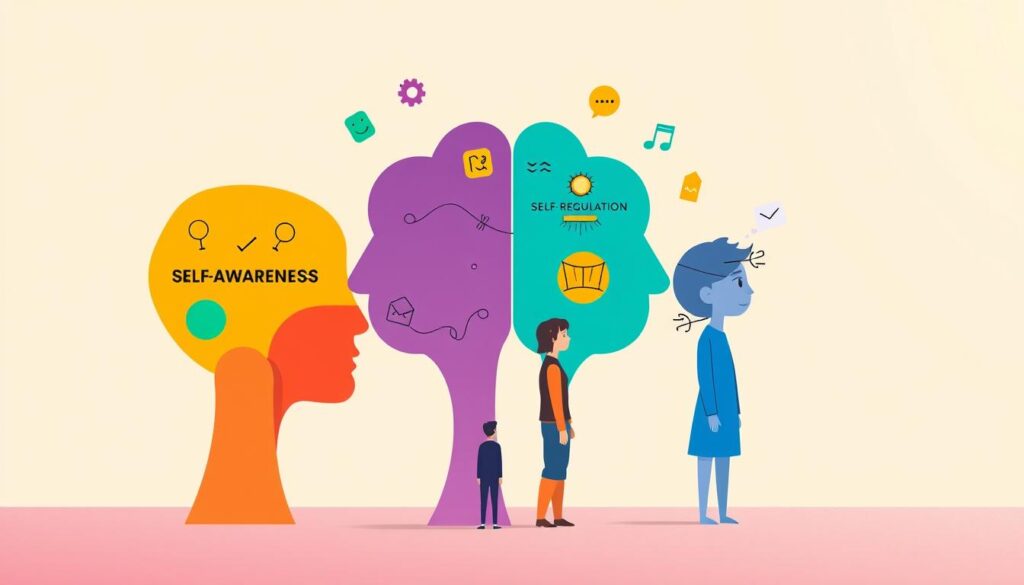What separates great leaders from the rest? While technical skills are important, research shows that emotional intelligence plays a bigger role in leadership success. In fact, 71% of employers now prioritize EQ over technical expertise.
Daniel Goleman, a pioneer in this field, linked EQ to executive performance. Studies by TalentSmart also confirm that EQ is the top predictor of workplace success. Leaders with high EQ excel in stress management, collaboration, and delivering feedback effectively.
Organizations thrive when leaders understand and manage emotions. Forbes Business Council recognizes EQ as a critical leadership skill. Tools like 360-degree feedback help leaders gain self-awareness and improve their impact.
This article explores the four core components of EQ and shares real-world examples of its transformative power. Ready to unlock your leadership potential? Let’s dive in.
Key Takeaways
- EQ is more valued than technical skills by 71% of employers.
- Daniel Goleman’s work highlights EQ’s role in executive success.
- EQ is the top predictor of workplace performance.
- Leaders with high EQ manage stress and collaborate effectively.
- 360-degree feedback enhances self-awareness for better leadership.
Introduction to Emotional Intelligence for Leaders
Leadership success often hinges on more than just technical expertise. In 1990, psychologists Mayer and Salovey defined emotional intelligence as the ability to recognize, understand, and manage emotions. This framework laid the foundation for understanding how EQ impacts leadership.
While technical skills are essential, managing relationships is equally critical. Research by DDI shows that empathetic leaders boost team performance by over 40%. This highlights the importance of EQ in achieving organizational goals.

The focus on leadership has shifted from IQ to EQ. Harvard Business Review emphasizes that modern executives must excel in emotional awareness. This evolution reflects the growing recognition of EQ’s role in driving success.
Unresolved conflicts can cost organizations 8 hours of productivity per incident, according to First Source. Leaders with high emotional intelligence are better equipped to handle such challenges, fostering a more collaborative and efficient workplace.
For mid-level managers, EQ acts as a career accelerator. Training programs focused on emotional intelligence can significantly enhance leadership capabilities, preparing individuals for higher roles.
Why Emotional Intelligence is Crucial for Leadership
The modern workplace demands more than just expertise. According to SHRM, 72% of employees prioritize respectful treatment, making emotional intelligence important for fostering job satisfaction. Leaders who understand and manage emotions create a positive environment where teams thrive.
In crisis situations, EQ plays a key role. Leaders with high EQ make better decisions under pressure, ensuring stability and confidence. This ability to stay calm and focused is a hallmark of effective leadership skills.
Team retention rates also improve with leaders who demonstrate EQ. Employees are more likely to stay in organizations where they feel valued and understood. This connection between leader EQ and retention highlights its impact on long-term success.
Reactive leadership often leads to conflicts, while responsive leadership fosters collaboration. Leaders with high EQ are responsive, addressing issues calmly and constructively. This approach builds trust and strengthens team dynamics.
EQ also drives innovation. Leaders who encourage open communication and creativity inspire their teams to think outside the box. This makes EQ a catalyst for growth and adaptability in the workplace.
The “double dividend” of EQ extends to both internal and external relationships. Internally, it boosts team morale. Externally, it enhances client and stakeholder interactions. This dual benefit underscores its value in leadership.
HBS Online’s Leadership Principles course highlights the measurable impact of EQ training. Leaders who develop these competencies see improved decision-making and team performance. Investing in EQ development yields significant returns.
Low EQ can lead to high executive turnover, costing organizations time and resources. Leaders who lack emotional awareness often struggle to maintain relationships, resulting in increased recruitment and training expenses.
In hybrid work environments, EQ is more critical than ever. Leaders must navigate virtual and in-person dynamics, ensuring all team members feel connected and supported. This adaptability is essential for modern leadership.
Quantifying the ROI of EQ is straightforward. Reduced turnover and training costs, combined with higher productivity, make it a smart investment. Organizations that prioritize EQ see tangible benefits in both culture and performance.
The Four Components of Emotional Intelligence
Understanding the core elements of EQ can transform leadership effectiveness. These components form the foundation of how leaders interact with themselves and others. Mastering them leads to better decision-making, stronger relationships, and improved team performance.

Self-Awareness
Self-awareness is the cornerstone of EQ. Tasha Eurich’s research reveals that 85-90% of professionals overestimate their self-awareness. This gap can hinder personal and team growth. Leaders with low self-awareness reduce team success by up to 50%.
To bridge this gap, tools like 360-degree feedback are invaluable. They provide insights into blind spots and areas for improvement. Journaling is another effective technique. Writing daily reflections helps leaders audit their emotions and reactions.
Self-Management
Self-management involves controlling emotions and adapting to change. Leaders who excel in this area remain calm under pressure. They make thoughtful decisions instead of reacting impulsively. This skill is critical in high-stakes situations.
Practicing mindfulness can enhance self-management. Techniques like deep breathing and meditation help leaders stay focused. Setting clear goals also aids in maintaining emotional balance.
Social Awareness
Social awareness is the ability to understand and empathize with others. DDI’s research shows that empathetic leaders boost team performance by over 40%. This skill fosters trust and collaboration within teams.
Active listening is key to developing social awareness. Leaders should pay attention to verbal and non-verbal cues. Showing genuine interest in team members’ concerns builds stronger connections.
Relationship Management
Relationship management focuses on building and maintaining positive interactions. Leaders with this skill resolve conflicts effectively and inspire their teams. They create an environment where everyone feels valued.
Open communication is essential for relationship management. Leaders should encourage feedback and address issues promptly. Recognizing and celebrating team achievements also strengthens bonds.
How to Identify a Lack of Emotional Intelligence
Recognizing gaps in emotional awareness is the first step toward improvement. Leaders who struggle with EQ often exhibit specific behaviors that hinder their effectiveness. Identifying these signs can help address critical gaps and foster growth.
Start with a self-assessment. Ask yourself diagnostic questions like: Do I remain calm under pressure? How well do I understand the emotions of my colleagues? Am I able to resolve conflicts constructively? These questions provide insights into areas needing improvement.
For a more comprehensive evaluation, a 360-degree assessment is essential. This requires feedback from at least three colleagues to ensure validity. Their perspectives can reveal blind spots and highlight areas for development.

Physical manifestations of poor emotional regulation are also telling. Signs like frequent irritability, inability to focus, or visible stress during meetings indicate low EQ. These behaviors can disrupt team dynamics and reduce productivity.
Communication patterns are another red flag. In Slack or email, overly aggressive or dismissive messages suggest a lack of empathy. Leaders with high EQ, on the other hand, communicate clearly and respectfully, fostering collaboration.
Meeting dynamics can further expose EQ deficiencies. Leaders who dominate conversations or ignore input create an environment of disengagement. In contrast, inclusive leaders encourage participation and value diverse perspectives.
Project post-mortems also reveal EQ gaps. Teams led by emotionally aware leaders analyze failures constructively, focusing on solutions rather than blame. This approach strengthens trust and encourages innovation.
High vs. low EQ team environments differ significantly. High EQ teams are collaborative, supportive, and productive. Low EQ teams often experience tension, miscommunication, and reduced morale.
Alignment assessments between managers, peers, and reports are crucial. Discrepancies in feedback highlight areas where leaders need to improve their emotional skills. This alignment ensures a balanced and accurate evaluation.
HBS Online’s pre-program assessment requirements emphasize the importance of self-awareness and empathy. These foundational skills are critical for effective leadership and team performance.
Finally, EQ gaps directly impact financial performance. Organizations with emotionally intelligent leaders see higher productivity, lower turnover, and better financial outcomes. Investing in EQ development is a strategic move for long-term success.
Strengthening Your Emotional Intelligence
Building stronger leadership starts with mastering emotional awareness. Harvard Business School’s Leadership Principles course offers a structured 4-week training program to develop these skills. Participants learn self-awareness, empathy, and relationship management through interactive modules and real-world applications.
One effective method is the 30-day emotional journaling framework. This practice helps leaders track their emotions, identify patterns, and improve self-regulation. By reflecting daily, individuals gain insights into their reactions and behaviors, fostering personal growth.

Body scan techniques are another powerful tool. These exercises involve focusing on physical sensations to recognize emotions in real-time. Leaders can use this method to stay calm under pressure and make thoughtful decisions.
Harvard’s program, priced between $2,850 and $3,100, delivers significant ROI. Graduates report improved decision-making, stronger team dynamics, and enhanced career prospects. The investment pays off through increased productivity and reduced turnover.
Meeting preparation rituals also play a role. Leaders can practice active listening and empathy before discussions, ensuring constructive and inclusive conversations. This approach fosters collaboration and trust within teams.
MSys Technologies’ peer coaching model is another valuable resource. Pairing leaders for mutual feedback and support accelerates skill development. This collaborative approach encourages continuous learning and improvement.
Feedback interpretation matrices help leaders analyze input effectively. By categorizing feedback into actionable insights, individuals can address weaknesses and build on strengths. This structured method ensures meaningful progress.
Expanding emotional vocabulary is equally important. Leaders who can articulate their feelings accurately communicate more effectively. This skill enhances relationships and reduces misunderstandings.
Mapping EQ competencies to promotion timelines provides a clear path for advancement. Leaders can identify key skills needed for higher roles and focus their development efforts accordingly.
Finally, program completion data shows a direct link between EQ training and salary increases. Leaders who invest in their emotional skills often see significant financial rewards, making it a smart career move.
The Impact of Emotional Intelligence on Team Performance
The way leaders handle emotions can make or break team success. Research by CCL shows that leaders with high emotional awareness improve team performance by over 40%. This highlights the impact of understanding and managing emotions in the workplace.
Teams led by emotionally aware individuals experience lower turnover rates. TalentSmart’s data reveals that organizations with high EQ leaders retain employees longer. This stability fosters stronger relationships and boosts productivity.

Meetings become more efficient when leaders facilitate with emotional awareness. Teams spend less time resolving conflicts and more time focusing on goals. This approach leads to faster decision-making and better outcomes.
Innovation thrives in environments where psychological safety is prioritized. Leaders who encourage open communication see a significant increase in creative ideas. This drives growth and keeps organizations competitive.
Cross-department collaboration also improves with emotionally aware leadership. Teams work together more effectively, breaking down silos and achieving shared objectives. This synergy enhances overall performance.
Project completion rates are higher in teams with emotionally intelligent leaders. They navigate challenges calmly and keep teams motivated. This results in timely and successful project delivery.
Customer satisfaction scores correlate with leadership EQ. Teams led by empathetic leaders deliver better service, leading to higher Net Promoter Scores (NPS). This strengthens client relationships and drives loyalty.
In crisis situations, emotionally aware leaders recover faster. They maintain composure and guide their teams through challenges effectively. This resilience minimizes disruptions and ensures continuity.
Glassdoor ratings are higher for organizations with high EQ leaders. Employees feel valued and supported, leading to positive reviews. This enhances the company’s reputation and attracts top talent.
Finally, shareholder value increases with emotionally intelligent leadership. Organizations that prioritize EQ see higher productivity, lower costs, and better financial outcomes. This makes EQ a strategic investment for long-term success.
Emotional Intelligence in Leadership Training
Effective leadership development often begins with structured training programs. Harvard Business School offers both online and on-campus formats, with 14 and 16 hours of instruction, respectively. These programs are designed to enhance self-awareness, empathy, and relationship management.
The 360-assessment is a critical component of the program. It provides detailed feedback from peers, subordinates, and supervisors. This helps participants identify blind spots and areas for improvement. The assessment is implemented early in the program to guide personalized development plans.

Cost-benefit analysis shows that the $2,850 online program and the $3,100 on-campus option both deliver significant ROI. Graduates report improved decision-making and stronger team dynamics. Post-training promotion rates are notably higher for participants, with many advancing to senior roles within a year.
Allen Lewis, a recent graduate, shared his experience: “The program transformed my approach to leadership. I now manage conflicts more effectively and inspire my team to achieve their best.” His testimonial highlights the real-world impact of the training.
The curriculum includes five key components: self-awareness, self-management, social awareness, relationship management, and practical applications. These elements are reinforced through interactive modules and case studies. Pre-work assessments ensure participants are prepared to maximize the program’s value.
Cohort networking is another valuable aspect of the program. Participants build lasting connections with peers from diverse industries. This network provides ongoing support and collaboration opportunities, enhancing the long-term benefits of the training.
Comparing EQ training to technical skill certifications, the former offers broader leadership benefits. It improves team performance, reduces turnover, and drives innovation. These outcomes make EQ training a strategic investment for organizations.
Looking ahead, AI-powered simulation training is set to revolutionize leadership development. These tools provide realistic scenarios for practicing emotional skills in a risk-free environment. This innovation will further enhance the effectiveness of EQ training programs.
Case Studies: Emotional Intelligence in Action
Real-world examples show how mastering emotions drives leadership success. From tech startups to Fortune 500 companies, organizations are seeing measurable results from EQ-focused strategies.
MSys Technologies reported a 23% productivity increase after implementing EQ training. Employees felt more connected and motivated, leading to higher output and better collaboration.
In the healthcare sector, patient satisfaction scores improved significantly. Leaders who prioritized empathy and communication built stronger relationships with both staff and patients.
A Fortune 500 company reduced conflict resolution time by 40%. Teams resolved issues faster, allowing them to focus on strategic goals and innovation.
Tech startups facing scaling challenges found success through EQ. Leaders who fostered open communication and adaptability navigated growth phases more effectively.
Nonprofit boards saw transformations in effectiveness. Members with high EQ built stronger partnerships and increased fundraising success.
Retention metrics improved across industries. Organizations with EQ-trained leaders saw higher employee satisfaction and lower turnover rates.
In manufacturing, safety records improved as leaders created a culture of trust and accountability. Employees felt valued and were more committed to safety protocols.
Financial services firms rebuilt client trust through emotionally aware leadership. Clear communication and empathy restored confidence and strengthened relationships.
Retail companies enhanced customer complaint resolution rates. Leaders who listened and responded thoughtfully turned negative experiences into positive outcomes.
In education, teacher retention rates increased. School leaders who demonstrated empathy and support created a more positive work environment.
These case studies highlight the transformative power of emotional awareness. Organizations that invest in EQ training see tangible benefits in productivity, retention, and overall success.
Future Trends in Emotional Intelligence for Leaders
The future of leadership is evolving rapidly, with new tools and expectations shaping how we manage teams. Over the next few years, leaders will need to adapt to emerging topics and technologies that enhance their ability to connect with others.
One key trend is the integration of AI-driven emotion recognition. This technology will help leaders better understand team dynamics and respond to emotional cues in real-time. It’s a game-changer for fostering collaboration and trust.
Neurofeedback training is another area gaining traction. By using brainwave monitoring, leaders can improve their self-regulation and decision-making skills. This approach offers a scientific way to enhance emotional awareness.
Generational differences in EQ expectations are also shaping leadership strategies. Younger employees often value empathy and transparency, requiring leaders to adapt their communication styles. Understanding these shifts is crucial for maintaining team cohesion.
Certification requirements for EQ skills are likely to become more common in hiring processes. Companies will prioritize candidates who demonstrate strong emotional awareness, making it a key factor in career advancement.
The metaverse presents unique challenges for leadership. Managing virtual teams requires a new level of emotional awareness to bridge the gap between digital and real-world interactions. Leaders must develop strategies to maintain connection and engagement.
Global teams will need standardized EQ practices to ensure consistency across cultures. This approach will help leaders navigate diverse perspectives and foster inclusivity in multinational organizations.
Real-time emotion analytics will become a standard tool for leaders. By analyzing emotional data during meetings or projects, leaders can make more informed decisions and address issues proactively.
EQ will also play a critical role in AI governance frameworks. Leaders must ensure that AI systems are designed with ethical considerations, balancing efficiency with empathy.
C-suite executives will increasingly rely on EQ dashboards to monitor team morale and performance. These tools provide actionable insights, helping leaders make data-driven decisions.
Finally, the climate crisis will demand leaders with high EQ to navigate complex challenges. Emotional awareness will be essential for inspiring action and fostering resilience in uncertain times.
Conclusion
Mastering self-awareness and empathy can redefine leadership effectiveness. With 71% of employers prioritizing these skills over technical expertise, the pathway to success lies in mastering the four components of EQ: self-awareness, self-management, social awareness, and relationship management.
Developing these skills not only accelerates career growth but also positions leaders as key players in pandemic recovery. Unlike technical skills, EQ offers a higher ROI by fostering collaboration, reducing turnover, and driving innovation.
Take the first step by initiating a 360-assessment to identify areas for improvement. As Forbes Business Council highlights, EQ is a critical differentiator in modern leadership. Programs like Harvard’s EQ training have proven success metrics, with graduates reporting enhanced decision-making and team dynamics.
Looking ahead, next-gen leadership will require even greater emotional awareness. Empower yourself today to lead with confidence and impact tomorrow.
FAQ
What is emotional intelligence in leadership?
It’s the ability to understand and manage your own feelings while influencing others positively. This skill helps leaders build stronger teams and improve workplace dynamics.
Why is emotional intelligence important for leaders?
Leaders with high emotional intelligence foster trust, improve communication, and drive better performance. It’s a key factor in creating a productive and harmonious work environment.
What are the four components of emotional intelligence?
The four components are self-awareness, self-management, social awareness, and relationship management. These elements work together to enhance leadership effectiveness.
How can I identify a lack of emotional intelligence in a leader?
Signs include poor communication, difficulty managing stress, and strained relationships with colleagues. These issues often lead to low team morale and reduced productivity.
How can leaders strengthen their emotional intelligence?
Practice active listening, seek feedback, and engage in self-reflection. Training programs and coaching can also help develop these critical skills.
How does emotional intelligence impact team performance?
Teams led by emotionally intelligent leaders tend to collaborate better, resolve conflicts effectively, and achieve higher levels of success. It creates a positive and supportive work culture.
Is emotional intelligence part of leadership training?
Yes, many programs now include it as a core component. Training focuses on developing self-awareness, empathy, and relationship-building skills to enhance leadership capabilities.
Are there real-world examples of emotional intelligence in leadership?
Yes, many successful leaders, like Satya Nadella of Microsoft, have demonstrated its impact. Their ability to connect with teams and drive innovation highlights its importance.
What are future trends in emotional intelligence for leaders?
Trends include integrating AI tools for emotional assessments and focusing on mental health. Leaders will also prioritize empathy and adaptability in an evolving workplace.






